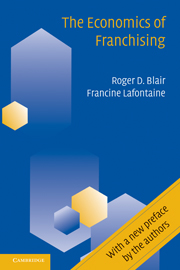Book contents
- Frontmatter
- Contents
- Preface
- 1 Introduction
- 2 Four Popular Misconceptions about Franchising
- 3 Franchise Contracts
- 4 Franchising, Vertical Integration, and Vertical Restraints
- 5 Quality Control
- 6 Franchise Tying Contracts
- 7 Vertical Price Controls in Franchising
- 8 Encroachment
- 9 Advertising and Promotion
- 10 Termination and Non-Renewal
- 11 Concluding Remarks
- Articles, Books, and Other Publications
- Cases, Codes, and Statutes
- Index
10 - Termination and Non-Renewal
Published online by Cambridge University Press: 24 May 2010
- Frontmatter
- Contents
- Preface
- 1 Introduction
- 2 Four Popular Misconceptions about Franchising
- 3 Franchise Contracts
- 4 Franchising, Vertical Integration, and Vertical Restraints
- 5 Quality Control
- 6 Franchise Tying Contracts
- 7 Vertical Price Controls in Franchising
- 8 Encroachment
- 9 Advertising and Promotion
- 10 Termination and Non-Renewal
- 11 Concluding Remarks
- Articles, Books, and Other Publications
- Cases, Codes, and Statutes
- Index
Summary
Introduction
The vast majority of franchise contracts are of finite duration, but contract duration varies considerably across franchise chains: some contracts are as short as 5 years while others are as long as 20 or 30 years. The contracts also usually stipulate an option to renew and the duration of the potential renewal period(s). In their 1998 survey of franchise contracting practices, Frandata and the IFA found that 91 percent of franchise contracts included an option to renew. Moreover, most of the time, franchise agreements are indeed renewed. In a small number of cases, however, even franchisors who offer such an option choose not to renew a specific contract. Further, franchisors sometimes terminate a franchisee's existing contract within the contract period.
In this chapter, we first describe in more detail what we know about contract duration. We show in particular that franchise contracts are typically quite long-term. We also provide some information on termination and renewal rates. We then examine the role of contract duration, termination, and non-renewal in franchising, specifically the effect these have on franchisees' willingness to invest both capital and effort in their franchised unit. We also discuss the issue of franchisee and franchisor opportunism and how these relate to termination and non-renewal. Next, we examine how the common law treats the termination and non-renewal of franchise contracts in the United States, and then describe how several states within the United States further regulate termination and non-renewal in their franchise relationship laws.
- Type
- Chapter
- Information
- The Economics of Franchising , pp. 258 - 290Publisher: Cambridge University PressPrint publication year: 2005



